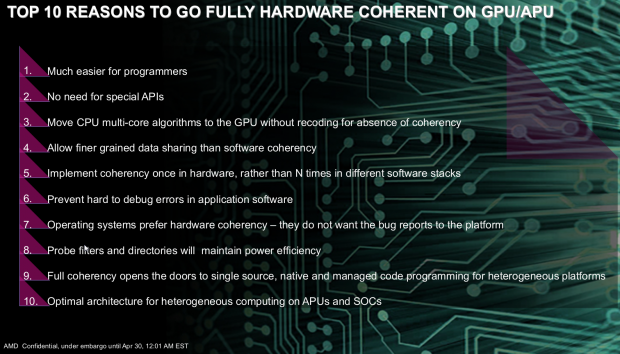A conferência deste ano trouxe alguns anúncios interessantes:
- Criação da HSA Foundation
http://semiaccurate.com/2012/06/12/amd-and-arm-joined-by-imagination-ti-and-mediatek/
- AMD 2013 APUs To Include ARM Cortex-A5 Processor For TrustZone Capabilities
- AMD Announces CodeXL At AFDS 12: A Unified Debugging and Profiling Tool for Heterogeneous Applications
Esta última poderá estar relacionada com o HSA roadmap, que prevê uma maior integração em 2013

http://www.tomshardware.com/news/amd-fusion-trinity-apu-liveblog,15986.html
- Criação da HSA Foundation
http://hsafoundation.com/hello-hsa-foundation/AMD , ARM, Imagination Technologies, MediaTek Inc., and Texas Instruments (TI) are the initial founding members of the HSA Foundation.
About the HSA Foundation
The HSA (Heterogeneous System Architecture) Foundation is a not-for-profit consortium for SoC IP vendors, OEMs, academia, SoC vendors, OSVs and ISVs whose goal is to make it easy to program for parallel computing. HSA members are building a heterogeneous compute ecosystem, rooted in industry standards, for combining scalar processing on the CPU with parallel processing on the GPU while enabling high bandwidth access to memory and high application performance at low power consumption. HSA defines interfaces for parallel computation utilizing CPU, GPU and other programmable and fixed function devices, and support for a diverse set of high-level programming languages, thereby creating the next foundation in general purpose computing.
About Heterogeneous System Architecture (HSA)
Developers will benefit from the open standard programming of HSA for both the CPU and GPU, which allows the two processors to work cooperatively and directly in system memory. Additionally, HSA provides a single architecture across multiple operating systems and hardware designs. By maximizing the full compute capabilities of systems with both CPUs and GPUs, users can see performance and energy efficiency boosts across a variety of applications.
http://semiaccurate.com/2012/06/12/amd-and-arm-joined-by-imagination-ti-and-mediatek/
- AMD 2013 APUs To Include ARM Cortex-A5 Processor For TrustZone Capabilities
http://www.anandtech.com/show/6007/...rtexa5-processor-for-trustzone-capabilities/1In order to implement a hardware security platform on their future APUs, AMD has chosen to enter into a strategic partnership with ARM for the purpose of gaining access to ARM’s TrustZone technology. By licensing TrustZone, AMD gains a hardware security platform that’s already in active use, which means they avoid fragmenting the market and the risks that would bring. Furthermore AMD saves on the years of work – both technical and evangelical – that they would have needed had they rolled their own solution. Or more simply put, given their new willingness to integrate 3[SUP]rd[/SUP] party IP, licensing was the easy solution to getting a hardware security platform quickly.
But because TrustZone is an ARM technology (both in name and ISA) AMD needs an ARM CPU to execute it. So the key to all of this will be the integration of an ARM processor into an AMD APU, specifically ARM’s Cortex-A5 CPU. The Cortex-A5 is ARM’s simplest ARMv7 application processor, and while it’s primarily designed for entry-level and other lower-performance devices, as it turns out it fits AMD’s needs quite nicely since it won’t be used as a primary application processor.
http://www.eetimes.com/electronics-news/4375240/AMD-to-integrate-ARM-core-into-APUsVan Doom said AMD plans to offer its first APUs incorporating the Cortex-A5 core next year. The scheme will first be implemented in G-Series APUs for tablets and ultrathin PCs in 2013, then implemented across the firm's APU product line in 2014, he said.
- AMD Announces CodeXL At AFDS 12: A Unified Debugging and Profiling Tool for Heterogeneous Applications
http://semiaccurate.com/2012/06/12/amd-announces-codexl-at-afds/In its simplest form AMD’s CodeXL brings together AMD’s GPU compute tools and AMD’s CPU compute tools to enable faster and more robust development of OpenCL and GPU accelerated applications. CodeXL does not replace AMD traditional tools for CPU specific applications or for GPU rendering application...
One of the biggest features of AMD’s CodeXL is support for both OpenGL and OpenCL debugging. It also includes tools for doing both CPU and GPU code profiling.


Esta última poderá estar relacionada com o HSA roadmap, que prevê uma maior integração em 2013

http://www.tomshardware.com/news/amd-fusion-trinity-apu-liveblog,15986.html
Última edição:















